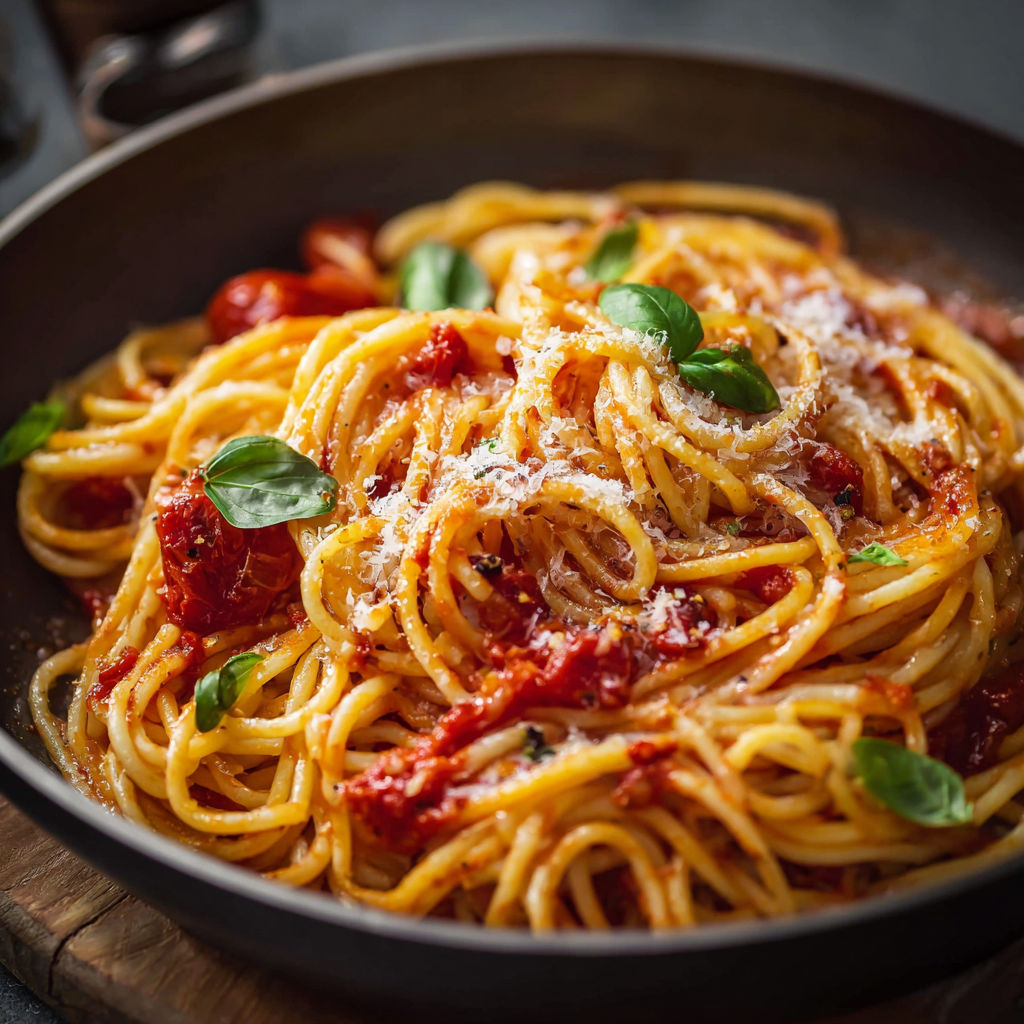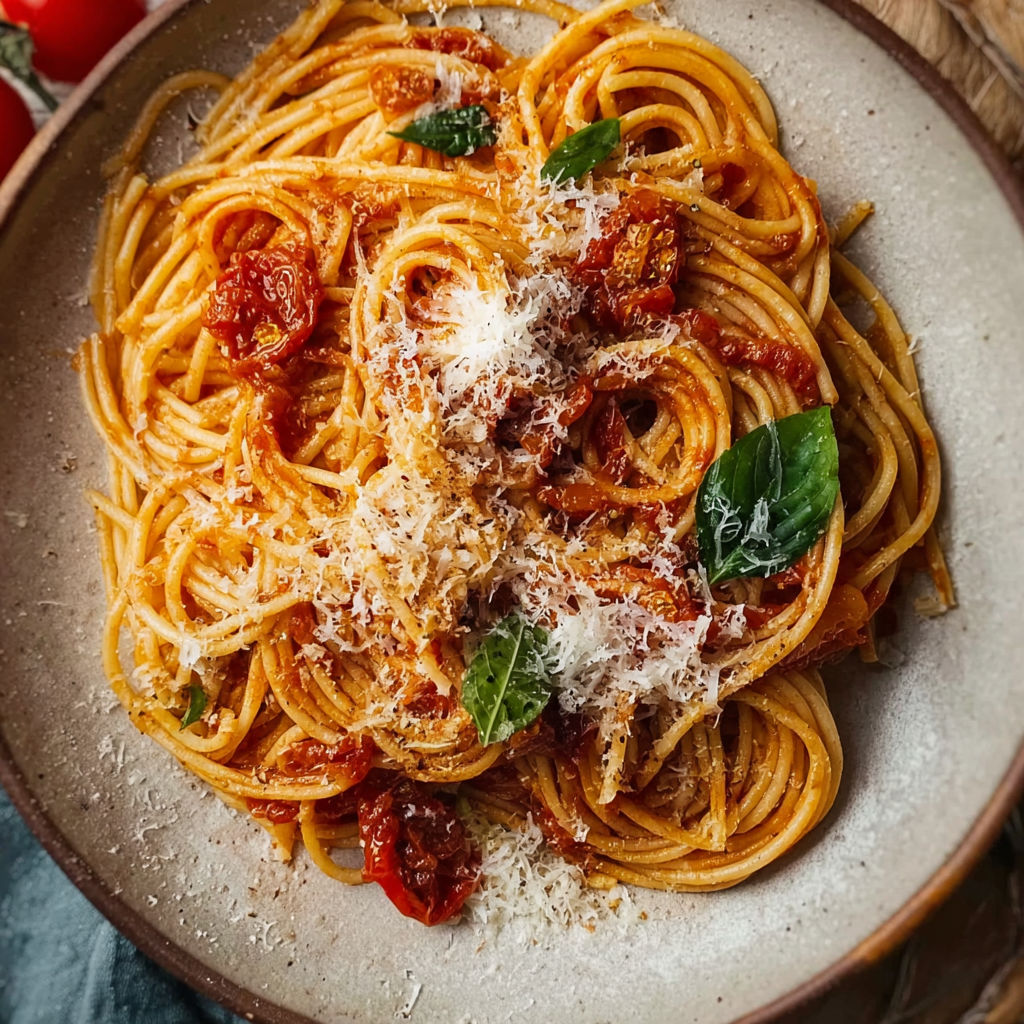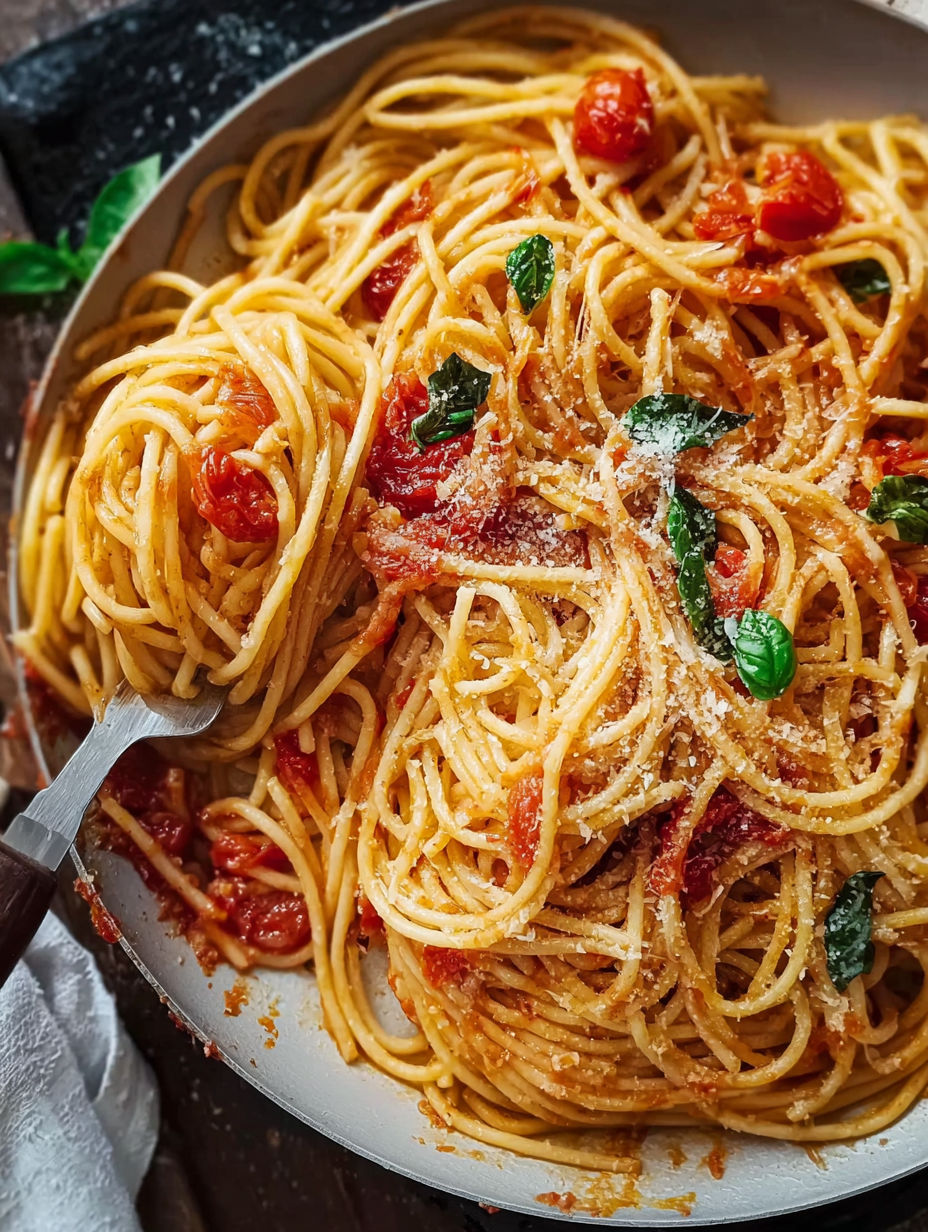 Pin it
Pin it
This standout spaghetti from The Bear TV show boils down classic Italian cooking to its core, letting a handful of top-notch ingredients work their magic in a well-balanced sauce. What makes it special? The flavor-packed oil and slowly browned onion that bring unexpected richness to what looks like a basic tomato sauce.
After watching all of The Bear in one sitting, I couldn't wait to try making Carmy's talked-about spaghetti. Now my kids ask for it every week, and I've noticed it works just as well for quick family meals as it does when I want to impress dinner guests with something special.
- Spaghetti pasta serves as the ideal base for this light sauce go for bronze-cut types as they grip the sauce better
- San Marzano tomatoes can't be skipped because of their natural sweetness and milder tang standard canned options will make your sauce sharper
- Yellow onion turns amazingly sweet when browned you'll put in half but take it out later
- Fresh basil leaves give the oil its wonderful aroma stick with fresh instead of dried here
- Red pepper flakes add a nice warmth without being too hot you can tweak how much you use
- Fresh garlic cloves are just crushed instead of chopped small for a gentler taste
- Butter brings a smooth richness that cuts through the tomato tang pick unsalted so you control the saltiness
- Olive oil starts everything off as your flavor base spending more on good extra virgin really pays off
- Parmesan cheese finishes things with the perfect savory touch grating it yourself makes a huge difference
Tasty Steps For The Bear Spaghetti
- Flavor your oil
- Pour olive oil into a small pot with crushed garlic, red pepper flakes, and fresh basil. Warm it on medium-low until you see tiny bubbles. Don't let the garlic burn or it'll taste bitter. Let everything bubble softly for 1-2 minutes then take it off the heat right away. The flavors will keep soaking into the oil as it cools down.
- Boil your pasta
- Fill a big pot with lots of salted water and bring it to a full boil. Drop in your spaghetti and cook until it's just firm when you bite it, usually around 8-10 minutes. Check by taking a bite - it should still have a tiny bit of firmness in the middle. Before you drain it, scoop out half a cup of the starchy cooking water. This water is super important for making a smooth sauce that sticks to every strand.
- Brown the onion
- Take half an onion and put the cut side down in a mix of melted butter and a bit of olive oil over medium-low heat. This part needs time - let it slowly turn golden for a full 8 minutes without moving it around. This slow cooking brings out all its natural sweetness that completely changes how your whole sauce tastes.
- Start your sauce
- Dump your canned tomatoes into the pot with the browned onion, smashing them up with a wooden spoon. Add some salt and let it bubble up before turning the heat down low. Pop a lid on and let it simmer for 8 minutes so the flavors can mix together while the sauce thickens up a bit.
- Mix everything together
- Take out the onion half and pour your flavored oil mix into the tomato sauce. Add the saved pasta water and let it all simmer without a lid for 5 minutes to blend the flavors. Use a stick blender to make it completely smooth like you'd get at a fancy restaurant. The sauce should be thick enough to coat a spoon but still easy to pour.
- Put it all together
- Toss your drained pasta straight into the sauce and keep stirring until every noodle is covered completely. Since the pasta will soak up some sauce after sitting, make sure it looks a little extra saucy before you serve it. Get it onto plates right away and top with freshly grated Parmesan and more basil if you want.
The real game-changer in this dish is definitely that browned onion half. The first time I made it, I thought skipping that step wouldn't matter since you throw it away anyway. Boy was I wrong! The difference was huge - that onion adds this gentle sweetness and depth that turns basic tomato sauce into something totally special.
Beautiful Food Made Simple
What makes this recipe so smart is how it holds back. Every ingredient has a clear job with nothing extra thrown in. Carmy from The Bear gets that great Italian food often comes from fewer ingredients treated right. By flavoring the oil separately, each taste gets to fully develop before they all come together. This creates clear flavor layers rather than just one blended taste.
 Pin it
Pin it
Changing Things Up
While sticking to tradition makes sense, you can still adjust things based on what you need. For a plant-based version, swap the butter for more olive oil or vegan butter. The sauce works great with gluten-free pasta too. If you can't find fresh basil, you can use dried herbs in the sauce, though fresh really makes the oil taste better. Want something heartier? Add some cooked Italian sausage or mushrooms to the sauce just before mixing in the pasta.
What To Serve With It
This spaghetti tastes amazing on its own with just some Parmesan on top, but it goes really well with a simple arugula salad dressed with lemon and olive oil. For a full Italian dinner, add some garlic bread and a glass of medium-bodied red wine like Chianti or Montepulciano. The sauce also tastes great with other pasta shapes like rigatoni or penne if you prefer pasta that can hold more sauce in its grooves.
 Pin it
Pin it
Frequently Asked Questions
- → Can I swap San Marzano tomatoes with other options?
Sure! Regular canned tomatoes work, but San Marzano gives a naturally sweeter flavor. If you switch, a touch of sugar can help balance the taste and offset more acidic tomatoes.
- → Why are the onions left whole in the sauce?
Whole onion halves let their sweetness spread evenly while keeping the sauce silky. They're removed before blending, which means smoothness with no chunks.
- → How does basil-infused oil improve the flavors?
By warming basil, garlic, and spices in olive oil, their flavors are drawn out and layered into the sauce evenly. This gives the dish a deeper, richer flavor that plain herbs can't achieve.
- → What is the purpose of saving pasta water?
The starchy water binds the sauce and noodles together, making the sauce stick to the pasta beautifully instead of pooling at the bottom of the plate.
- → Can I make the sauce ahead of time?
Absolutely! It lasts up to three days in the fridge or can be frozen for months. Flavors intensify as it sits, so it might even taste better the next day. Just reheat gently and toss with fresh pasta when ready to enjoy.
- → Is this dish vegetarian or vegan-friendly?
This is vegetarian-friendly with vegetarian Parmesan, as traditional cheese includes animal rennet. Swap the butter and cheese with plant-based options for an easy vegan twist, or add nutritional yeast for that umami kick.
